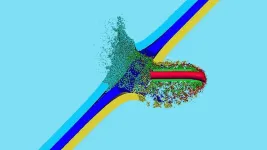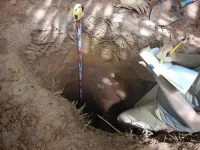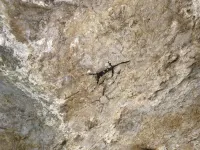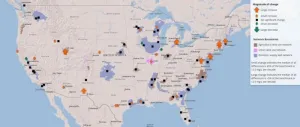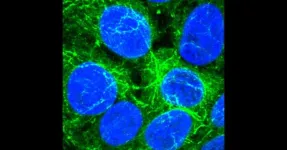Research finds water quality in Gulf of Mexico improves when adding social costs to carbon emissions
2023-10-17
(Press-News.org) DURHAM, N.H.—U.S. Climate policies can offer options for putting climate change efforts into place that solve environmental problems like excessive carbon dioxide in the atmosphere created by greenhouse gas emissions. Research led by the University of New Hampshire took a closer look at what would happen to agriculture if there was an extra cost, or so-called social cost, added to fossil fuels, which are essential for making fertilizer used in farming. They found that while CO2 emissions would decline by as much as 50%, the cost of fertilizer would rise leading to a significant benefit on water quality by lessening fertilizer runoff contributing to the Gulf of Mexico’s dead zone—a low-oxygen area that struggles with harmful algal blooms that threatens marine life.
“Excessive fertilizer use creates a growing number of water quality concerns so we wanted to explore the consequences of applying a social cost to fossil fuel prices which should reduce fertilizer use and decrease the amount of runoff going into the Mississippi River Basin and on to the Gulf of Mexico, an important fishery in the U.S.,” said Shan Zuidema, research scientist at UNH’s Earth System Research Center and lead author. “Our models showed that with this climate policy, U.S. carbon emissions could significantly decline but we could also see about a 3% to 4% reduction of the Gulf of Mexico dead zone in an average year.”
In the study, published in the journal Proceedings of the National Academy of Sciences (PNAS), researchers from UNH, Purdue University and the University of Wisconsin-Madison used four different models that looked at various factors making up the world economy. They focused on data from the global economy, U.S. agricultural economies, agroecology and hydrology/water quality to capture the impacts of the climate change mitigation policy on agriculture and the resulting water quality co-benefits. They analyzed a policy that would assign a range of social costs to fossil fuel-based CO2 emissions. The policy would raise energy costs and increase the price of nitrogen fertilizer production.
The researchers then considered three different levels of social costs applied to the fossil fuel and found at the highest carbon price the cost of nitrogen fertilizer could rise by roughly 90%. This could lead to upwards of a 16% decline in fertilizer application for corn production across the Mississippi River Basin and a roughly 9% decline in fertilizer loss to the environment. Corn and soybean production would decline by about 7%, increasing crop prices by 6%, while nitrate leaching would decline by about 10%. Nitrates entering the environment are removed in various ways as they move through the watershed, so the decline in nitrogen leaving the watershed at the mouth of the Mississippi River was somewhat less (roughly a 9% reduction).
“Implementing a carbon price that reflects its social cost allows the U.S. to meet its commitment to the Paris Accord while significantly improving water quality,” said Tom Hertel, professor of agricultural economics at Purdue University and project principal investigator. “Our models showed that with this range of climate policies, U.S. carbon emissions could decline by 29% to 50%, depending on the stringency of the carbon pricing. This represents 4.6% to 8% of global carbon emissions and satisfies the range of reductions outlined in the Paris Accord.”
Researchers also considered the additional benefits of restored wetlands to mitigate nitrogen loading to reduce hypoxia in the Gulf of Mexico and found a targeted wetland restoration scenario approximately doubles the effect of a low to moderate social cost of carbon.
The team hopes these findings provide important context for policy makers to consider all aspects of climate mitigation, as well as for those that want to consider alternatives for reducing contamination to the Gulf of Mexico.
Co-authors include Wilfred Wollheim and Stephen Frolking, both from UNH; Jing Liu, Maksym Chepeliev, David Johnson, Uris Baldos and Tom Hertel, all from Purdue University; and Christopher Kucharik, from the University of Wisconsin-Madison.
Funding for this research was provided by the Innovations at the Nexus of Food, Energy and Water Systems project funded by the National Science Foundation. Partial funding was provided by the New Hampshire Agricultural Experiment Station through the USDA National Institute of Food and Agriculture
The University of New Hampshire inspires innovation and transforms lives in our state, nation and world. More than 16,000 students from 49 states and 82 countries engage with an award-winning faculty in top-ranked programs in business, engineering, law, health and human services, liberal arts and the sciences across more than 200 programs of study. A Carnegie Classification R1 institution, UNH partners with NASA, NOAA, NSF, and NIH, and received over $210 million in competitive external funding in FY23 to further explore and define the frontiers of land, sea and space.
###
END
ELSE PRESS RELEASES FROM THIS DATE:
2023-10-17
In a major stride towards achieving fast-charging lithium-ion batteries (LIBs) with reliable cyclability, researchers at UNIST have made a groundbreaking discovery. Their study, published in the prestigious ACS Energy Letters, introduces a novel strategy of utilizing phosphorus nanolayers to enhance the lithiation kinetics and performance of graphite-based composites, without compromising safety.
Led by Professor Hyun-Wook Lee from the School of Energy and Chemical Engineering at UNIST, the research team developed a revolutionary graphite-phosphorus composite using a vaporization-condensation ...
2023-10-17
In 2020, the Pantanal, the largest tropical freshwater wetland in the world and a biodiversity hotspot, was swept by high-intensity fires that destroyed native vegetation in an area totaling 44,998 square kilometers (km²), or about 30% of the Brazilian portion of the biome, which spans some 150,000 km². The estimate is presented in an article published in the science journal Fire.
The area destroyed by that year’s disastrous fires was far larger than had been thought, according to the article. ...
2023-10-17
SAN ANTONIO — October 17, 2023 —Southwest Research Institute (SwRI) will continue advancing the Elastic Plastic Impact Computations (EPIC) dynamic finite-element code as part of an Other Transaction Prototype Agreement with the U.S Army Corps of Engineers. The first year’s funding of $500,000 has been awarded, with optional additional funding across the next three years totaling $3.5 million.
“EPIC uses finite element and particle methods to simulate complex impact and explosion scenarios,” said SwRI Staff Engineer Dr. Stephen Beissel, who leads the EPIC project and has been involved in EPIC’s development since the mid-1990s. ...
2023-10-17
17 October 2023
The Geological Society of America
Release No. 23-42
Contact: Justin Samuel
+1-303-357-1026
jsamuel@geosociety.org
For Immediate Release
Contributed by Sarah Derouin
Pittsburgh, Pa., USA: Earthworms, the hardworking invertebrates that grace the upper layers of soil, have long been considered helpful in our home gardens. Earthworms are prolific munchers, grinding up organic material and sediment grains that make up soils. Although they are very different animals, worms, like many poultry, have gizzards. “Worms will ingest some larger soil grains, and then they use the strongest and largest of those grains, retaining them in their gizzard,” ...
2023-10-17
17 October 2023
The Geological Society of America
Release No. 23-40
Contact: Justin Samuel
+1-303-357-1026
jsamuel@geosociety.org
For Immediate Release
Leer en español.
Contributed by Sarah Derouin
Pittsburgh, Pa., USA: In the karstic caves of Puerto Rico, cave art paints the rock walls. Previous research has assigned ages to this art based on the ages of nearby archaeological artifacts within the caves, but these ages are relative and may not reflect the true timing of the art creation.
Now, a new study to be presented Wednesday at the Geological Society of America’s GSA Connects 2023 meeting shows that researchers have refined the age of this rupestrian ...
2023-10-17
17 October 2023
The Geological Society of America
Release No. 23-41
Contact: Justin Samuel
+1-303-357-1026
jsamuel@geosociety.org
For Immediate Release
Contributed by Sarah Derouin
Pittsburgh, Pa., USA: Scientists from the U.S. Geological Survey (USGS) have been monitoring groundwater quality in wells across the country for more than three decades, looking for harmful chemicals or residual substances that may cause harm to ecosystems or humans. In all, they have measured up to 500 chemical constituents, including major ions, metals, pesticides, volatile organic compounds, fertilizers, and radionuclides.
Of ...
2023-10-17
Washington, D.C. – Blue light kills both dried cells and biofilms of the pathogen Listeria monocytogenes, a frequent contaminant of food processing facilities. Demise of L. monocytogenes occurred quickest when cells or biofilms were placed on polystyrene, a widely used, transparent form of plastic. The research is published in Applied and Environmental Microbiology, a journal of the American Society for Microbiology.
“These results contribute to advancing our understanding of the potential of blue light to treat inert surfaces contaminated with L. monocytogenes,” said corresponding author ...
2023-10-17
(Boston)— SARS-CoV-2, the causative agent of COVID-19, began impacting the U.S. in March 2020 with many schools and universities shifting to remote education by early April 2020 in response to the public health emergency. Despite public health interventions (increased ventilation, masking policies, surveillance testing, contact tracing of confirmed cases and quarantine procedures for infected students, faculty and staff) there were still concerns that institutes of higher education would be a hotbed of transmission, including transmission from students into surrounding communities.
But, were these fears warranted?
A ...
2023-10-17
CastleVax, a clinical stage vaccine platform company, has received a Project NexGen award valued at up to $338 million from the Biomedical Advanced Research and Development Authority (BARDA), part of the Administration for Strategic Preparedness and Response (ASPR) in the U.S. Department of Health and Human Services (HHS), to support the development of a next-generation, booster vaccine to protect against COVID-19 for years to come. The initial phase of the award provides approximately $8.5 million to plan a Phase 2b clinical trial that would compare CastleVax’s vaccine to currently ...
2023-10-17
Researchers at University of California San Diego have discovered a process in which liver cells share molecules via vesicle exchange in order to multiply under conditions that would ordinarily suppress cell proliferation. They also found evidence that this process occurs in various types of cancer cells, paving the way for a new approach to tackling treatment resistance in cancer. The findings were published on October 17, 2023 in eLife.
“Understanding cell proliferation is a fundamental issue in both cancer research and biomedical science as a whole,” said Gen-Sheng Feng, PhD, a professor of pathology at UC San Diego School of Medicine and of molecular biology ...
LAST 30 PRESS RELEASES:
[Press-News.org] Research finds water quality in Gulf of Mexico improves when adding social costs to carbon emissions

